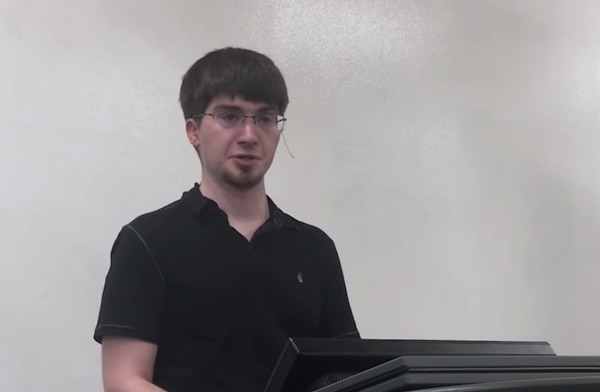Ian Goodfellow, Top AI Researcher at Google, Heads to Apple
 CNBC reported last week that Ian Goodfellow, formerly a top AI researcher at Google, now works for Apple. Mr. Goodfellow is best known for his work developing General Adversarial Networks (GAN) which have been praised by AI research luminaries ranging from Facebook’s top AI scientist Yann LeCun to Baidu’s Andrew Ng. A graduate of Standford with undergraduate and masters degrees in computer science, Goodfellow earned his PhD in machine learning from the Université de Montréal where he pioneered the GAN concept in an attempt to solve a problem faced both other students in his program. After graduation, he joined Google where he rose to the role of Senior Research scientist in less than two years and worked on both TensorFlow and the Google Brain team. He then spent a year as a research scientist at OpenAI and returned to Google for two more years. Goodfellow’s LinkedIn profile lists him as a director at Apple beginning in March 2019 which a description that says, “I’m a Director of Machine Learning in the Special Projects Group.”
CNBC reported last week that Ian Goodfellow, formerly a top AI researcher at Google, now works for Apple. Mr. Goodfellow is best known for his work developing General Adversarial Networks (GAN) which have been praised by AI research luminaries ranging from Facebook’s top AI scientist Yann LeCun to Baidu’s Andrew Ng. A graduate of Standford with undergraduate and masters degrees in computer science, Goodfellow earned his PhD in machine learning from the Université de Montréal where he pioneered the GAN concept in an attempt to solve a problem faced both other students in his program. After graduation, he joined Google where he rose to the role of Senior Research scientist in less than two years and worked on both TensorFlow and the Google Brain team. He then spent a year as a research scientist at OpenAI and returned to Google for two more years. Goodfellow’s LinkedIn profile lists him as a director at Apple beginning in March 2019 which a description that says, “I’m a Director of Machine Learning in the Special Projects Group.”
Is Apple Becoming Cool for AI?
Apple’s hiring of Goodfellow is the latest of several recent changes following the spring 2018 hiring of John Giannandrea, previously the head of search and AI at Google. Giannandrea was promoted to Apple CEO Tim Cook’s inner circle of executives a few months later. Key personnel changes subsequent to Giannandrea’s hiring include the departure of Siri co-founder Tom Gruber, along with the shift of the top Siri executive, Bill Stasior, to another role. However, Apple has also brought in several notable teams through acquisition including Lattice Data, Laserlike, and PullString. And, the company hired former Microsoft executive and smart home entrepreneur Sam Jadallah. Two years ago Apple was talking about its AI efforts as if there was a lot of activity, but it was clear to most industry observers that the company was falling behind as Google, Amazon, and Microsoft were moving forward quickly. These recent moves haven’t necessarily borne fruit yet, but you can see the foundation for increased activity and a vision that the company can pioneer as opposed to just follow in the space. Goodfellow is among the most sought-after AI researchers worldwide and the fact that he landed at Apple with former Google colleague Giannandrea is notable.
How Could Apple Use GANs
GANs are a technique that uses one machine learning model to generate new content (generative model) from source data while another machine learning model (discriminative model) attempts to determine if the content is real or generated. The output is successful when the discriminative model cannot distinguish the new content from the real, source content. It addressed a common issue of generative machine learning models not creating faithful representations. A 2018 Technology Review article summarized the challenge saying:
“Researchers were already using neural networks, algorithms loosely modeled on the web of neurons in the human brain, as “generative” models to create plausible new data of their own. But the results were often not very good: images of a computer-generated face tended to be blurry or have errors like missing ears…Supply a deep-learning system with enough images and it learns to, say, recognize a pedestrian who’s about to cross a road. This approach has made possible things like self-driving cars and the conversational technology that powers Alexa, Siri, and other virtual assistants…While deep-learning AIs can learn to recognize things, they have not been good at creating them. The goal of GANs is to give machines something akin to an imagination.
The best-known use of GANs today is for producing “deep fakes” such as videos of famous people doing and saying things that never occurred. They are completely computer generated but often very convincing. The question then is how Apple could use GANs to support its current product efforts. Apple’s interest in augmented and virtual reality (AR/VR) is an obvious application. There are also considerations for voice and not only Siri’s performance, but how the solution could change if the voice assistant could be imbued with “imagination” in the spirit of the Technology Review comment. Regardless, Goodfellow’s hiring indicates that Apple may increasingly be viewed as a cool place to be even if, and maybe especially if, you are an AI researcher. In the war for talent, Apple’s big cash balance was not enough when researchers thought it was not hospitable to fundamental AI research. That may be changing.
Follow @bretkinsella Follow @voicebotai
Apple Launches New AirPods with Voice Activated Siri and Wireless Charging









